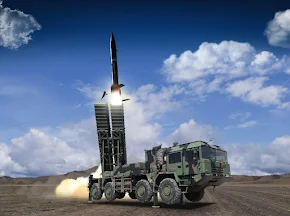 |
| Khan-2 Ballistic Missile |
The Khan is a new Turkish ballistic missile system. Khan is an international name, while locally this system is known as the Kaan. It was first publicly revealed in 2017. During the last couple of years, Turkey made several attempts to purchase short-range ballistic missiles from NATO countries. However, NATO condemned these potential purchases, causing Turkey to look for missiles from non-NATO countries and to produce them domestically. Some sources report that this Turkish ballistic missile system was adopted in 2017.
The missile can be launched by a multi-barrel rocket launcher (MBRL) with 8x8 wheels. To the customer’s requirements, it can also be launched from other tactical wheeled vehicle platforms with integration-compatible interfaces.
System Specifications
- Combat Proven
- 24/7 All Weather/Terrain Usage Capability
- Ready to Fire in a Short Time
- Highly Accurate
- Low Collateral Damage
- Anti-Jamming/Anti-Spoofing Solutions
Also Targets
- Targets Located with High Accuracy
- Artillery and Air Defence Systems
- Radar Sites
- Assembly Areas
- Logistic Facilities
- C3 Facilities
- Other High Priority Targets
Technical Specifications
- Diameter 610 mm
- Weight 2.500 kg
- Range 80 - 280 km
- Guidance GPS*+GLONASS** Aided INS***
- Control Aerodynamic Control with Electromechanical Actuation System
- Propellant Type Composite Solid
- Warhead Type High Explosive
- Warhead Weight 470 kg
- Fuze Type Point Detonating and Proximity
- Accuracy [CEP] ≤ 10 m
- GPS Global Positioning System
- **GLONASS Global Navigation Satellite System
- ***INS Inertial Navigation System
- ****CEP Circular Error Probability
Missile Info
Originally, the Bora tactical ballistic missile was a product of Turkish–Chinese defense cooperation, centered on China’s B-611 baseline. The Turkish 300-mm MBRL and the J-600T battlefield ballistic missile were linked to the aforementioned bilateral military ties between Ankara and Beijing, which were established in the late 1990s.
Turkey’s new missile has a range of 280 km and has GPS / INS guidance. Whereas the Chinese B-611 has a CEP (circular error probable) of some 50 meters, open-source evidence suggests that ROKETSAN has managed to reduce it to some 10 meters for Bora, making the missile more accurate. The missile can carry a conventional warhead with a 450-kg payload. Considering the MTCR (missile technology control regime) restrictions, and given the fact that Turkey also seeks to export Bora, current specifications of the missile depict it as a reliable, combat-tested tactical asset.
Battlefield ballistic missiles
The Bora tactical ballistic missile has the potential to provide robust war-fighting capabilities for the Turkish Armed Forces from a military perspective. The missile is road-mobile, carried by a TELAR (transporter-erector-launcher). Road-mobile missiles are more survivable on the battlefield, as they can be deployed to different launch positions flexibly. While fixed launch sites could come under adversaries’ preventive strikes, locating and targeting TELARs necessitates a consuming intelligence effort. Secondly, Bora is a solid-propellant missile. Thereby, it has a shorter launch cycle compared to liquid-propellant missiles (i.e. the Scud family of ballistic missiles) and requires less personnel to operate.
Third, thanks to its low CEP and some 450 kg warhead, it can eliminate a broad array of targets on the battlefield, ranging from bases to troop concentrations and even critical infrastructure that falls within its range. Such a firepower, coupled with pinpoint accuracy, provides Turkey with many options. In fact, armed conflicts in Yemen and Ukraine showed that even the Cold War-remnant, inaccurate Tochka (SS-21 Scarab) missiles with a great CEP can inflict massive damage. Thus, new-generation ballistic missiles with more unpredictable terminal homing paths and small CEP can really register game-changer results.










0 Comments